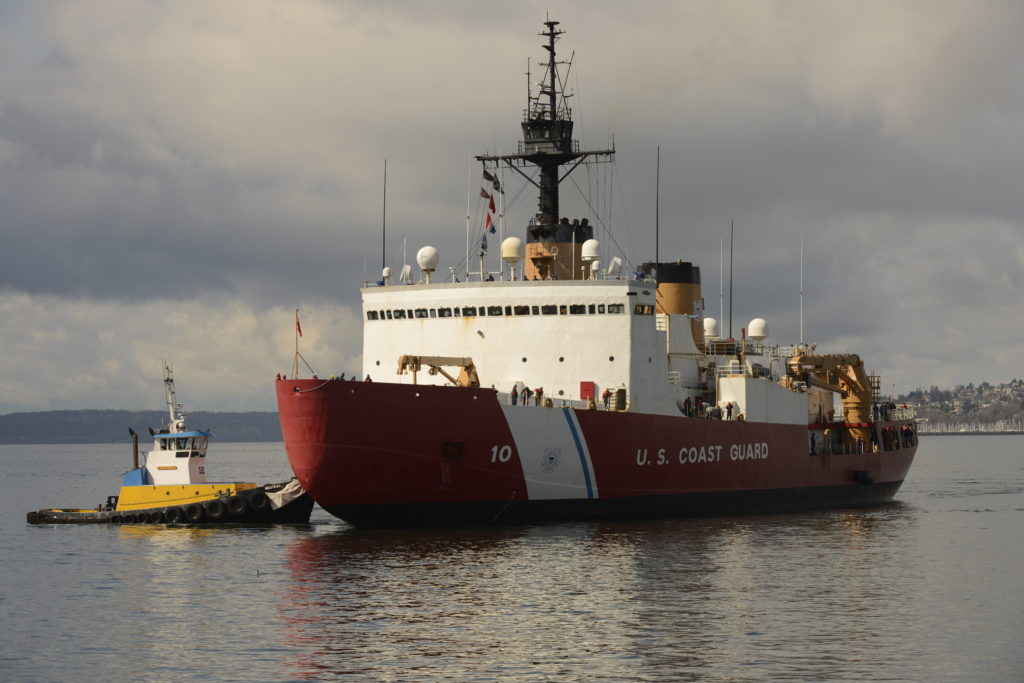
SEATTLE — The 150-member crew of the U.S. Coast Guard Cutter Polar Star returned Wednesday to their homeport of Seattle following a 123-day deployment to Antarctica in support of Operation Deep Freeze.
This mission marks the Polar Star’s 23rd journey to Antarctica in support of Operation Deep Freeze, an annual joint military service mission to resupply the United States Antarctic stations, in support of the National Science Foundation – the lead agency for the United States Antarctic Program. This year also marks the 63rd iteration of the annual operation.
The USCGC Polar Star crew departed Seattle on Nov. 27, 2019, for their sixth deployment in as many years and traveled more than 26,350 miles through the North Pacific, South Pacific, Indian and Southern Oceans.
In the Southern Ocean, the crew travelled through nearly 500 miles of pack ice and broke through 23 miles of fast ice in order to create a nearly 18-square-mile navigable channel to McMurdo Station, Antarctica. Because of the efforts of the Polar Star crew, two resupply vessels and one tanker travelled to McMurdo Station unescorted in order to refuel and resupply U.S. Antarctic stations.
This year’s operation required the construction of a temporary, modular mobile causeway to replace an ice pier, which disintegrated during Operation Deep Freeze 2018-2019. The modular pier required a three-day construction period prior to the offload of supplies, followed by a three-day deconstruction period at the conclusion of the mission.
Three resupply ships required 23 days to offload 19.6 million pounds of cargo and 7.6 million gallons of fuel during this year’s operation, more than doubling the operation duration and capacity as previous years. Together, the three ships delivered enough fuel and critical supplies to sustain NSF operations throughout the year until Polar Star returns in 2021.
Among the cargo offloaded were construction materials for a five-year, $460 million Antarctica Infrastructure Modernization for Science (AIMS) project to recapitalize McMurdo Station, South Pole Station and other American outposts on the continent.
Additionally, the Coast Guard Cutter Polar Star crew also supported a team of U.S. government officials from the U.S. Department of State, National Science Foundation, National Oceanic and Atmospheric Administration and U.S. Coast Guard who conducted a five-day inspection of foreign research stations, installations and equipment in Antarctica.

U.S. Coast Guard photo by PA3 Michael Clark.
The United States continues to promote Antarctica’s status as a continent reserved for peace and science in accordance with the provisions of the Antarctic Treaty of 1959. The inspection serves to verify compliance with the Antarctic Treaty and its Environmental Protocol, including provisions prohibiting military measures and mining, as well as provisions promoting safe station operation and sound environmental practices.
The team inspected three stations: Mario Zucchelli (Italy), Jang Bogo (South Korea), and Inexpressible Island (China). This was the fifteenth inspection of foreign research stations by the United States in Antarctica and the first since 2012.
Inspections emphasize all of Antarctica is accessible to interested countries despite territorial claims and reinforce the importance of compliance with the Antarctic Treaty’s arms control provisions. The United States will present its report on the inspection at the next Antarctic Treaty Consultative Meeting in Helsinki, Finland, in May 2020.
“I am very proud of the tenacity of this Polar Star crew,” said Coast Guard Capt. Greg Stanclik, commanding officer of the Polar Star. “158 crew members earned the Antarctic Service Medal during Operation Deep Freeze 2020. The words inscribed on the back of the medal are Courage, Sacrifice and Devotion. Each and every one exhibited the courage to make this 123-day Antarctic voyage, sacrificed time away from their loved ones and devoted themselves to executing this nationally critical mission.”
Commissioned in 1976, the Polar Star is the United States’ only operational heavy icebreaker, capable of breaking ice up to 21 feet thick. Reserved for Operation Deep Freeze each year, the ship spends the winter breaking ice near Antarctica, and when the mission is complete, returns to dry dock in order to conduct critical maintenance and repairs in preparation for the next Operation Deep Freeze mission.
If a catastrophic event, such as getting stuck in the ice, were to happen to the Coast Guard Cutter Healy (WAGB 20) in the Arctic or to the Polar Star near Antarctica, the U.S. Coast Guard is left without a self-rescue capability.
By contrast, Russia currently operates more than 50 icebreakers – several of which are nuclear powered.
The Coast Guard has been the sole provider of the nation’s polar icebreaking capability since 1965 and is seeking to increase its icebreaking fleet with six new polar security cutters to ensure continued national presence and access to the Polar Regions.
In April 2019, the Coast Guard awarded VT Halter Marine Inc. of Pascagoula, Mississippi, a contract for the design and construction of the Coast Guard’s lead polar security cutter, which will also be homeported in Seattle. The contract also includes options for the construction of two additional PSCs.
«Replacing the Coast Guard’s icebreaker fleet is paramount,» said Vice Adm. Linda Fagan, commander of the Coast Guard’s Pacific Area. «Our ability to clear a channel and allow for the resupply of the United States’ Antarctic stations is essential for continued national presence and influence on the continent.»
-USCG-

